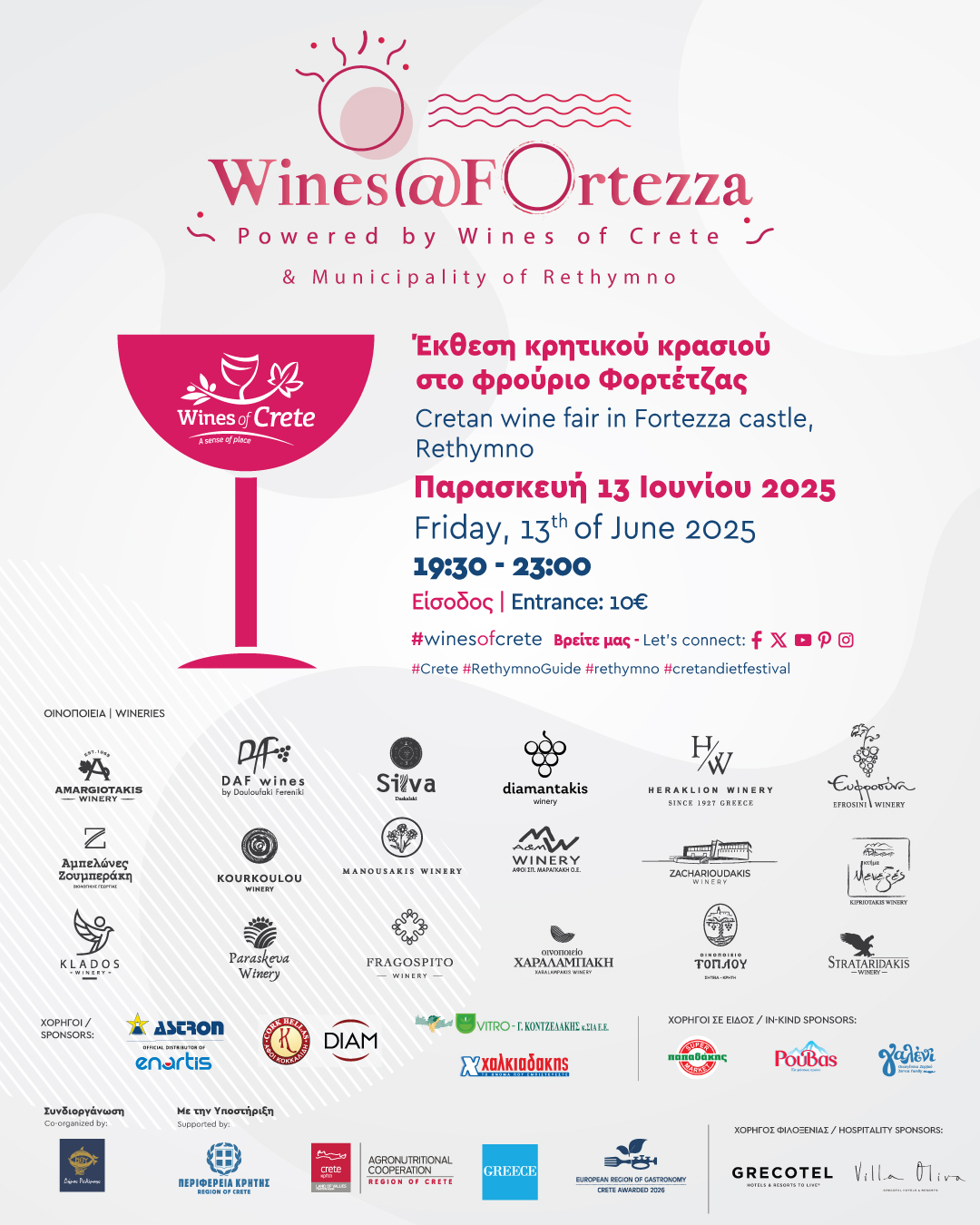The Compelling Wines of Crete
The Greeks might be better known for being the architects of democracy, but they have an even longer wine history, stretching back at least 3,500 years on the island of Crete.
You might assume that centuries of wine making would mean that the wine industry hit its stride a long time ago. But it has only been since 2003 that the wine region on this formerly tumultuous island has achieved even a modicum of interest. To understand why you need to know two very specific events which posed significant roadblocks for the wine industry. The first occurred in the mid 1970s when Phylloxera hit the island and devastated most of the old vineyards. As is often the case however the little louse produced big changes when the vineyards were replanted. The second problem occurred in late 1998. The legislature, in an effort to “promote” and hold on to the indigenous grape varieties, proposed a law allowing for the extensive planting of almost exclusively Vilana, one of Crete’s native white grapes, but also one of its least promising. As stunning as it seems, the law passed and the expansion of vineyards with a multitude of unique grape varieties was hamstrung, and Vilana became over-planted. The law was finally overturned, and the freedom to plant any grapes you want has allowed for, literally, a resurrection of the ancient wine growing traditions on Crete.
However it is Vidiano which has emerged as Crete’s flagship white wine. “Vidiano is full of apples, yellow fruits, rich but balanced aromas – velvet body, round with a twist of oily texture, with a refreshing acidity,” says Nicolas Miliarakis of Minos- Miliarakis Winery, located in the Peza region of Heraklion. But there are other whites native to the island including Dafni, and Plyto, and you’ll find Chardonnay, Sauvignon Blanc and the like. As for the reds, well, reds are not the strong suit here, however there are some very solid examples of what red wine can achieve. In the Heraklion region, Kotsifali is an indigenous grape but it needs a blending partner to round out the rough edges. Syrah is the best partner I tasted, though there were a few blends using Merlot and Cabernet, but the Syrah grown here is universally a better vinified wine than even the Bordeaux varieties. “Kotsifali has elements of spicy prunes, leather, cinnamon, small red fruits,” says Nicolas Miliarakis. “It doesn’t have a deep red color (that’s why we blend), but it does have a long after taste, matching very well with tomato and onion sauces, goat and lamb, ingredients that characterize Cretan cuisine,” he says.
Heraklion
Located just outside of the port city of Heraklion, Crete’s capital, Domain Paterianakis is at the forefront of wine tourism. In addition to the winery open to the public, they also have a bed and breakfast on site; four rooms that come with a breakfast basket and free wine tasting. Their facility looks down to low rolling hills and out to the Cretan Sea. The dirt road up to the property might seem inhospitable at first, a bumpy uphill journey but once at the top, almost as if on cue, a stocky bearded sheep herder passes by me, the staccato clinking of tin bells around the necks of the goats punctuating the stillness. The winery and B&B were built using stones from the property and they were the first to farm organically – and as proof this is working there are plenty of bees on the property keeping the vineyard healthy and that is reflected with a bee logo on their bottles. Their rosé made with Kotsifali and Syrah is one of the best on the island.
The calcium rich soils of Tamiolakis Winery help to make wines like their flagship Ekti Ekdosi (meaning ‘Sixth Edition’), an extracted blend of Kotsifali, Cabernet Sauvignon, and Merlot. “This wine is a blend of our Cretan past and French history,” says Maria Tamiolakis. I tasted the 2008 and 2009 iterations, both different and impressive, showing that Cretan blended wines have structure, finesse and are comprehensive with layered fruit. Minos-Miliarakis Winery also makes a terrific Kotsifali, but adds Mandilari for color and tannic structure, and Mourvèdre, spending eight months in oak. Douloufakis Winery planted their grapes in 1996 on American rootstock and owner Nicos Douloufakis makes Liatiko, another native variety usually reserved for sweet wines as it has a propensity to oxidize quickly, but his dry red version was perfect with the Greek lamb I had and the wine shows notes of black cherry, pepper, lavender and resin.
On a windswept hill Zacharias Diamantakis and his namesake winery have impressive views of a patchwork quilt of vineyards and olive trees as far as the eye can see. Zacharias let me sample his 2010 and 2011 Vidiano and while both very good, the 2011 showcases this grape perfectly with clean, bright acidity, and body and depth, perfect with seafood which is ubiquitous in Crete. “I love this variety, it is our future,” he says of Vidiano. In addition he produces a second label called Prinos and makes Chardonnay and Syrah for the international market and Diamantakis has pulled in several Decanter awards.
Chania
Moving west, there are less than 10 wineries outside the lovely port city of Chania and this region differs from Heraklion typically with less wind but more heat and it allows Crete to showcase more international varieties like Chardonnay, Grenache, even Tempranillo. Manousakis Winery offers Rhone styled wines, Syrah, Roussanne and Grenache which fall under the Nostos label are available in the States. You can get a tour and tasting here for €3.5, or a light lunch of Cretan food, tasting and two glasses of wine which will run €15 per person. And this is where Crete is a great value: local fresh foods, native grapes and unique experiences at prices you can’t find in better known wine regions. Of note they have a few old olive trees on the property, one of which was planted in 1290 AD, a massively twisted and gnarled trunk, still producing fruit and a thing of beauty in its own right.
At Dourakis Winery there is a charming tasting room made of hewn stone blocks, a mini agriculture and winemaking museum, and two art gallery spaces, and their wines are all under €10. There is a clear acidity on the white wines, potent little numbers that cry out for food but which are effective in their simplicity and which reflect the local region. Just down the road the beautiful tasting room of Karavitakis Winery represents exactly what Crete is working so hard for: namely wines that are compelling, using international varieties, but not shying away from the native grapes which make Crete so unique. Clearly visitors to Crete will not be familiar with many of the native grapes, therefore well-known wines like Merlot offer an easy introduction to traditional Cretan reds, and Karavitakis bridges this gap very well. Karavitakis Winery are producing perhaps the most diverse portfolio. Their Syrah for example is a dusty tannic wine, oaked aged with elements of blackberry and leather, similar to their fine Cabernet Sauvignon with its blueberry, blackberry and cocoa notes. Other producers to look for in Crete include Domain Zacharioudakis (who make very nice Kotsifali blends), Alexakis Winery (their Vidiano is a terrific value), and Lyrarakis whose Okto label blend of Vilana, Muscat and Sauvignon Blanc is another wonderful value wine and available in the U.S.
The beauty of the bourgeoning Cretan wine industry is that it is tourist friendly and you’ll find wines here you simply cannot find anywhere else. A visit to this island will provide an opportunity to sample what very well might become world-class wines in the making.


